Unit 8 Is there a post office near here 复习课件-七年级英语下册同步精品课堂(人教版)
文档属性
| 名称 | Unit 8 Is there a post office near here 复习课件-七年级英语下册同步精品课堂(人教版) | 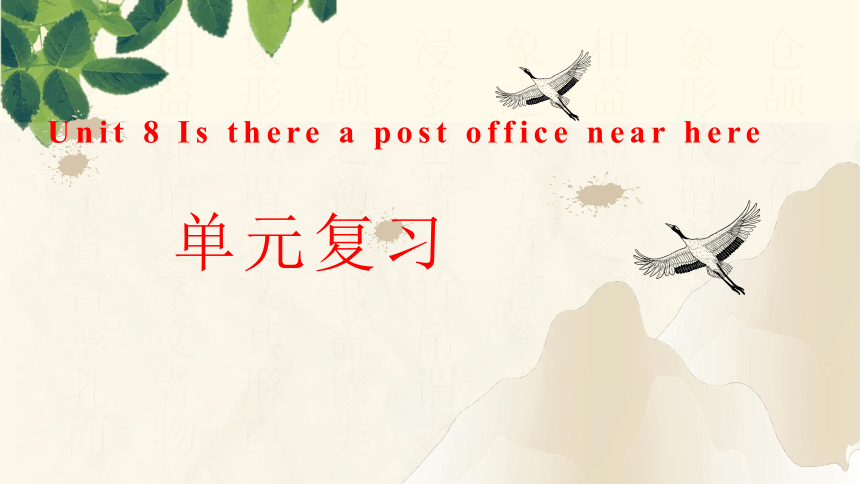 | |
| 格式 | pptx | ||
| 文件大小 | 4.7MB | ||
| 资源类型 | 试卷 | ||
| 版本资源 | 人教新目标(Go for it)版 | ||
| 科目 | 英语 | ||
| 更新时间 | 2024-03-18 21:26:00 | ||
图片预览

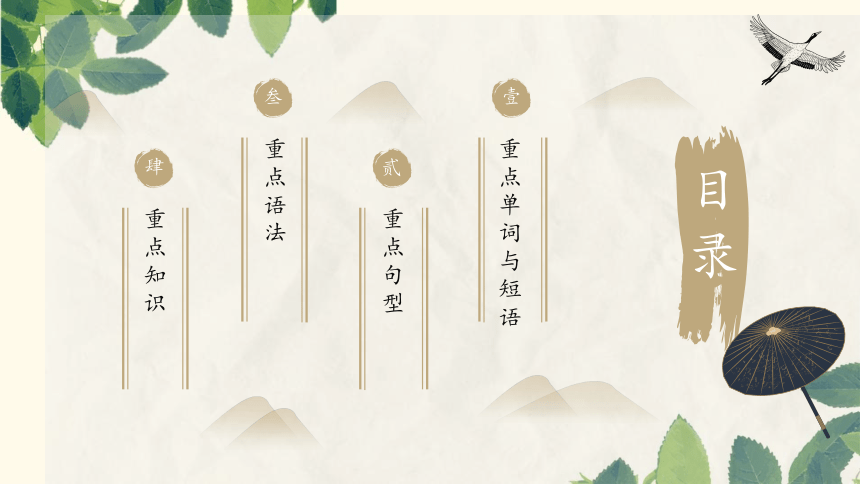

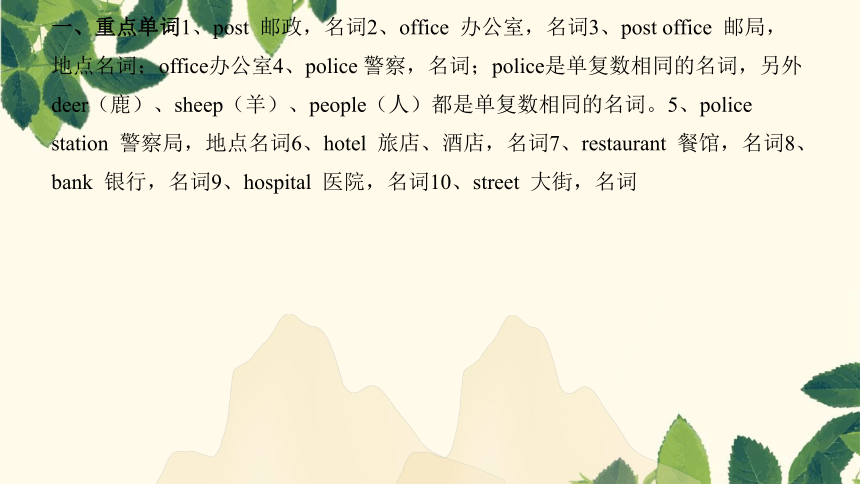
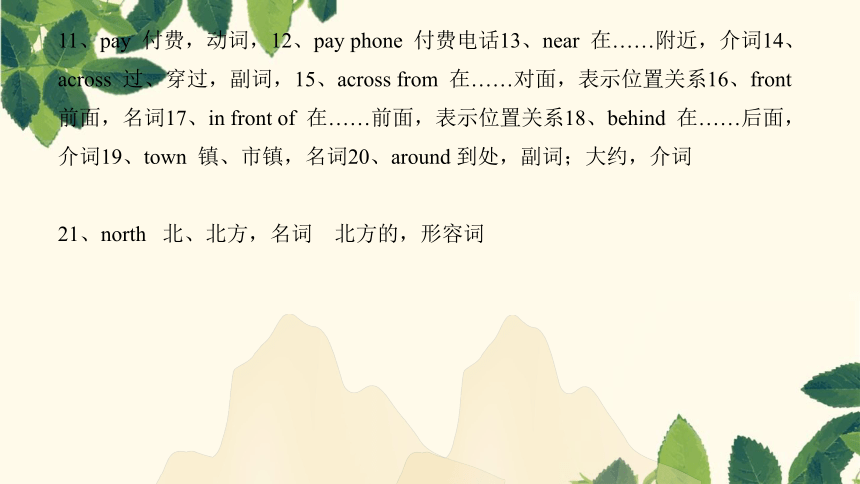
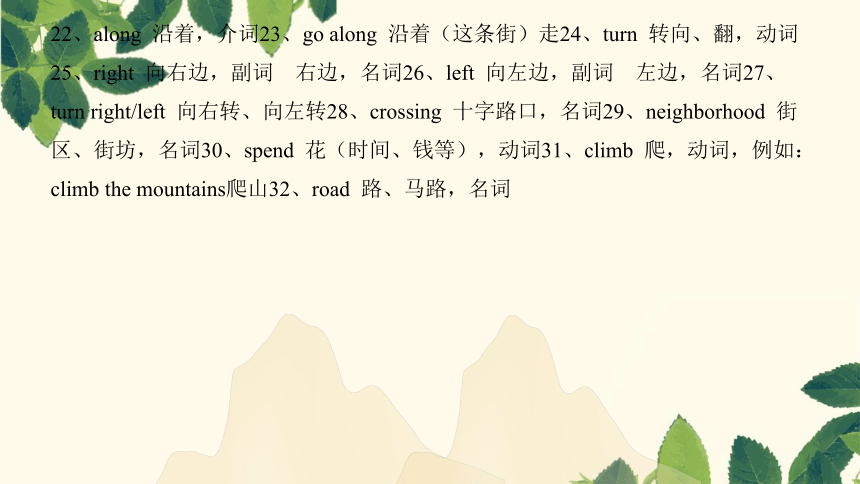
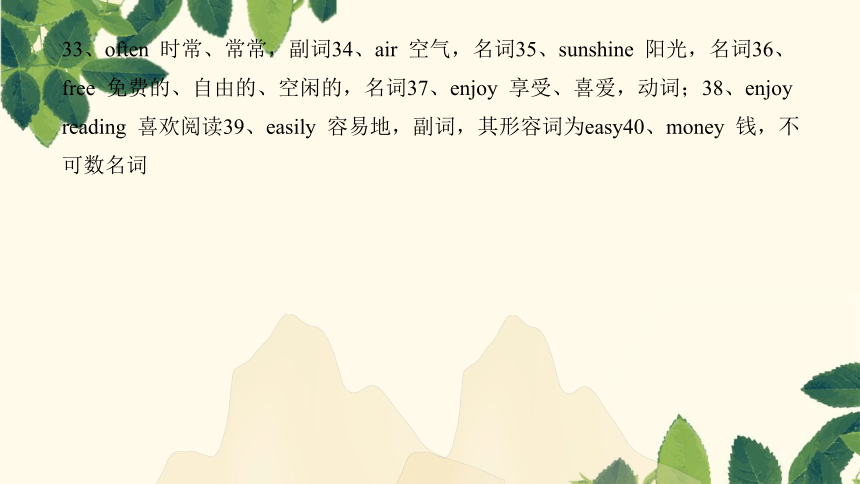
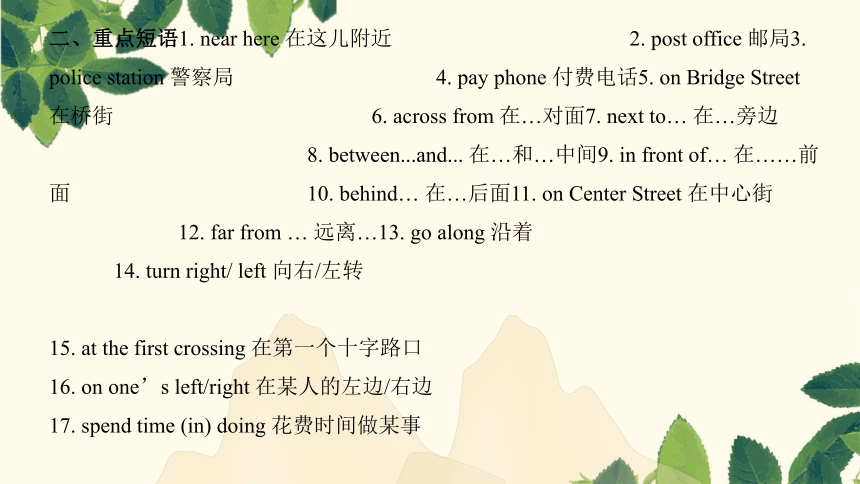


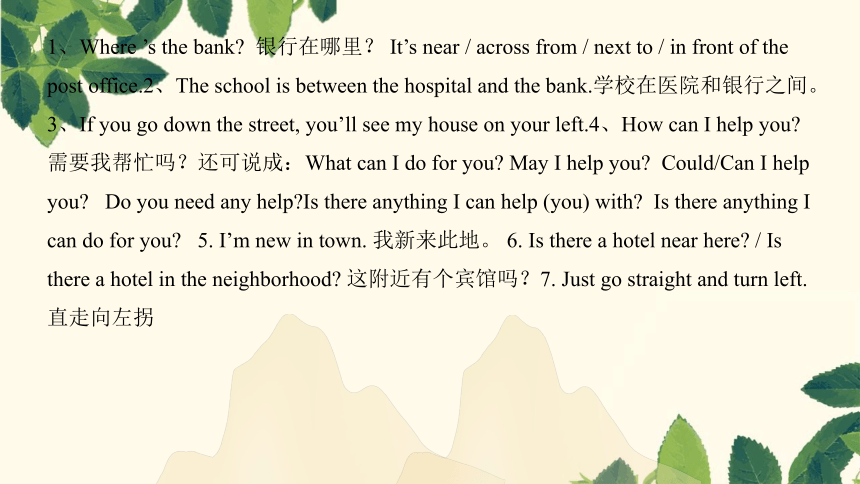
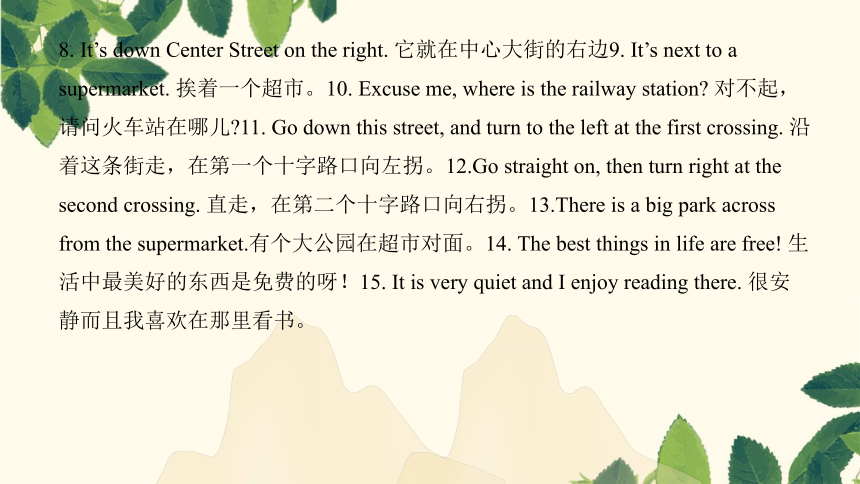
文档简介
(共61张PPT)
仓颉之初作书盖依类象形故谓之文其形声相益即谓之字文者物象之本字者言孳乳而浸多也著于竹帛谓之仓颉之初作书盖依类象形故谓之文其形声相益即谓之字文者物象之本字者言孳乳而
单元复习
Unit 8 Is there a post office near here
重点单词与短语
壹
重点句型
贰
重点语法
叁
重点知识
肆
目录
仓颉之初作书盖依类象形故谓之文其形声相益即谓之字文者物象之本字者言孳乳而浸多也著于竹帛谓之仓颉之初作书盖依类象形故谓之文其形声相益即谓之字文者物象之本字者言孳乳而
重点单词与短语
第一部分
壹
一、重点单词1、post 邮政,名词2、office 办公室,名词3、post office 邮局,地点名词;office办公室4、police 警察,名词;police是单复数相同的名词,另外deer(鹿)、sheep(羊)、people(人)都是单复数相同的名词。5、police station 警察局,地点名词6、hotel 旅店、酒店,名词7、restaurant 餐馆,名词8、bank 银行,名词9、hospital 医院,名词10、street 大街,名词
11、pay 付费,动词,12、pay phone 付费电话13、near 在……附近,介词14、across 过、穿过,副词,15、across from 在……对面,表示位置关系16、front 前面,名词17、in front of 在……前面,表示位置关系18、behind 在……后面,介词19、town 镇、市镇,名词20、around 到处,副词;大约,介词
21、north 北、北方,名词 北方的,形容词
22、along 沿着,介词23、go along 沿着(这条街)走24、turn 转向、翻,动词25、right 向右边,副词 右边,名词26、left 向左边,副词 左边,名词27、turn right/left 向右转、向左转28、crossing 十字路口,名词29、neighborhood 街区、街坊,名词30、spend 花(时间、钱等),动词31、climb 爬,动词,例如:climb the mountains爬山32、road 路、马路,名词
33、often 时常、常常,副词34、air 空气,名词35、sunshine 阳光,名词36、free 免费的、自由的、空闲的,名词37、enjoy 享受、喜爱,动词;38、enjoy reading 喜欢阅读39、easily 容易地,副词,其形容词为easy40、money 钱,不可数名词
二、重点短语1. near here 在这儿附近 2. post office 邮局3. police station 警察局 4. pay phone 付费电话5. on Bridge Street 在桥街 6. across from 在…对面7. next to… 在…旁边 8. between...and... 在…和…中间9. in front of… 在……前面 10. behind… 在…后面11. on Center Street 在中心街 12. far from … 远离…13. go along 沿着 14. turn right/ left 向右/左转
15. at the first crossing 在第一个十字路口
16. on one’s left/right 在某人的左边/右边
17. spend time (in) doing 花费时间做某事
18. watch sb. doing sth. 看见某人正在做某事19. look like 看起来像20. love the clean air and sunshine 喜爱清新的空气和阳光21. the best things 最好的事情 22. be free 免费的23.cross Center street 穿过中心街 24. have to do sth. 不得不做某事25. a noisy neighborhood 喧闹的街区26.get to the library easily 很容易到达图书馆27. enjoy doing sth. 喜欢做某事 28. go shopping 去购物29. be busy 忙的 30. make the foods 做食物
仓颉之初作书盖依类象形故谓之文其形声相益即谓之字文者物象之本字者言孳乳而浸多也著于竹帛谓之仓颉之初作书盖依类象形故谓之文其形声相益即谓之字文者物象之本字者言孳乳而
重点句型
第二部分
贰
1、Where ’s the bank 银行在哪里? It’s near / across from / next to / in front of the post office.2、The school is between the hospital and the bank.学校在医院和银行之间。3、If you go down the street, you’ll see my house on your left.4、How can I help you 需要我帮忙吗?还可说成:What can I do for you May I help you Could/Can I help you Do you need any help Is there anything I can help (you) with Is there anything I can do for you 5. I’m new in town. 我新来此地。 6. Is there a hotel near here / Is there a hotel in the neighborhood 这附近有个宾馆吗?7. Just go straight and turn left. 直走向左拐
8. It’s down Center Street on the right. 它就在中心大街的右边9. It’s next to a supermarket. 挨着一个超市。10. Excuse me, where is the railway station 对不起,请问火车站在哪儿 11. Go down this street, and turn to the left at the first crossing. 沿着这条街走,在第一个十字路口向左拐。12.Go straight on, then turn right at the second crossing. 直走,在第二个十字路口向右拐。13.There is a big park across from the supermarket.有个大公园在超市对面。14. The best things in life are free! 生活中最美好的东西是免费的呀!15. It is very quiet and I enjoy reading there. 很安静而且我喜欢在那里看书。
仓颉之初作书盖依类象形故谓之文其形声相益即谓之字文者物象之本字者言孳乳而浸多也著于竹帛谓之仓颉之初作书盖依类象形故谓之文其形声相益即谓之字文者物象之本字者言孳乳而
重点语法
第三部分
叄
一、there be 结构 构成: There be ...句型表示的是 “某处有(存在)某人或某物”,其结构为 There be(is,are, was, were )+名词+地点状语。
There are fifty-two students in our class. There is a pencil in my pencil-case. 用法: 1.否定句: 在 be 后加上“not”,也可用“no”来表示。即:no + n.(名词)= not a\an\any + n. (名词) There is an orange in her bag.
→There isn’t an orange in her bag. →There is no orange in her bag. There are some oranges in her bag.
→There aren’t any oranges in her bag. →There are no oranges in her bag. There is some juice in the bottle.
→There isn’t any juice in the bottle. →There is no juice in the bottle.
1. 一般疑问句: There be 结构的一般疑问句变化只需把 be 动词移到句首,再在句尾加上问号即可。 There is some money in her handbag.
→ Is there any money in her handbag (疑问句和否定句中,some 改为 any, something 改为 anything.) There is something new in today’s newspaper. →Is there anything new in today’s newspaper 2. 特殊疑问句: There be 句型的特殊疑问句有以下三种形式 ① 对主语提问:当主语是人时,用 “Who’s + 介词短语 ”;当主语是物时,用 “What’s + 介词短语 ”。其中 there 在口语中常常省略。注意:无论原句的主语是单数 还是复数,对其提问时一般都用 be 的单数形式(回答时却要根据实际情况来决定)。如: There is a bird in the tree.
→What’s in the tree There are some bikes over there.
→What’s over there There is a little girl in the room.
→Who is in the room
② 对地点状语提问:用 “Where is \ are + 主语 ”表示(注意其答语变化): There is a computer in my office. → Where is the computer ----It’s in my office. There are four children in the classroom.
→Where are the four children --They’ re in the classroom. ③ 对数量提问:一般有两种提问方式: 如果主语是可数名词,无论是单数还是复数,都用“How many +可数名词复数 + are there + 介词短语?”表示: There are twelve months in a year. →How many months are there in a year There is only one book in my bag. → How many books are there in your bag There is a cat in the box.
→ How many cats are there in the box 如果主语是不可数名词,则用“ How much + 不可数名词 + is there + 介词短语?” 表示: There is some money in my purse.
→ How much money is there in your purse
3. 反意疑问句: There be 或 There 加其它动词,其反意疑问句一律用…there There is a beautiful girl in the garden, isn’t there There be 句型中 be 动词的形式要和其后的主语在人称和数上保持一致。 There is a basketball in the box. There is a little milk in the glass.
There are many birds in the tree. 如果有两个或两个以上的名词作主语,be 动词要和最靠近它的那个主语在数上保 持一致,也就是我们常说的 “就近原则”。 There is an orange and some bananas in the basket.
There are some bananas and an orange in the basket.
4. There 与 be 中间可插入一些表推测的情态动词、表时态的短语(如和将来时 be going to\ will、现在完成时 have\has + pp. ) There must be a pen in the box.
Is there going to be a dancing party tonight There is not going to be a meeting tonight.5. There be 句型与 have/has 的区别:
There be 句型表示客观存在;have/has 表示主观拥有 There be 句型不能与 have/has 连用。
二、Excuse me Excuse me的意思是“对不起、请原谅、打扰一下”。这是英语中经常用到的表示客气的礼貌用语,用于向对方提出请求、询问情况、打扰或者麻烦别人等情景中。Excuse me 具体用于以下几种情况:(1)向别人问路的时候。
Excuse me, where is the bank 劳驾,请问银行在哪里?(2)客气地向别人提出请求(允许)。Excuse me, may I use your bike 对不起,我可以用一用你的自行车吗?(3)向别人打听或者询问情况的时候。 Excuse me, is this your bike 麻烦一下,这是你的自行车吗?(4)和别人谈话的时候需要中断或者做别的事情。 Excuse me, just a moment. 对不起,请稍等一下。
Excuse me与sorry的辨析 Excuse me主要用于问路、插话、打扰或者麻烦别人的情景中;而sorry表示“道歉”,经常用于:(1)自己有过失,做错了事情表示道歉。 I am sorry. I lost your book. 对不起,我把你的书丢失了。(2)听到别人的痛苦或者不幸的消息表示同情。 -My mother was ill.我妈妈病了。
-I am sorry to hear that.听到这个消息我很难过。(3)表示委婉拒绝或者不同意。
Sorry. You can’t sit here. 对不起。你不能坐在这里。(4)因失约、失礼而表示歉意。 -Can you come to my party 你能来参加我的聚会吗
-Sorry. I can’t. 对不起,我不能。 回答I am sorry可以用:It doesn’t matter. That’s all right/OK. That’s nothing. Never mind.
问路:Excuse me, is there a post office in the neighborhood/near here/around here Excuse me, where is the post office Excuse me, could you tell me where the post office is Excuse me, can you tell me the way to the post office Excuse me, where is the nearest post office Excuse me, could you tell me how to get to the post office Excuse me, could you tell me how I can get to the post office Excuse me, how can I get to the nearest post office Excuse me, do you know where the post office is Excuse me, could you tell me which is the nearest way to the post office
指路:
Yes, there is. It’s...Walk/Go down/along... Turn right/left at the first crossing.
Take the first crossing on the right/left.You can take the NO.1 bus and get off at the square.It’s on Center Street./behind the police station./next to the park./across from the shop./between the hospital and the library./in front of /at the end of the park.
仓颉之初作书盖依类象形故谓之文其形声相益即谓之字文者物象之本字者言孳乳而浸多也著于竹帛谓之仓颉之初作书盖依类象形故谓之文其形声相益即谓之字文者物象之本字者言孳乳而
重点知识
第四部分
肆
1. police station 警察局
police集体名词,意为“警察;警方”。作主语时,谓语动词用复数形式。The police are looking for the little boy.警察正在寻找这个小男孩。【拓展】policeman和policewoman为可数名词,意思分别为“男警察”和“女警察”,其复数形式分别为policemen和policewomen。
I want to be a policeman.
我想当一名警察。There are three policemen in the office.
办公室里有三名男警察。
2. Is there a hospital near here 这附近有一家医院吗?
1)Is there ... 意为“有……吗?”,是there be句型的一般疑问句形式,把be动词放在句首,句末用问号,读时句末用升调。其肯定回答是“Yes,there is.”;否定回答是“No,there isn’t.”。
—Is there a bank near here 这附近有一家银行吗?—Yes,there is.是的,有。
2)near介词,意为“在……附近”。
The supermarket is near here. 超市就在这附近。
【拓展】near 还可以作形容词用,意为“近的,附近的”,反义词是far(远的)。 be near to意为“ 离…..近”。
His home is near to the school. 他家离学校很近。
there be句型的基本构成为:There be+名词+地点,表示“某个地方存在有某人/某物”。其中there是引导词,be没有实际意义,主语是后面的名词,be要随其后主语的单复数的不同而选用相应的形式。即be 要跟与它最近名词的数保持一致。
There be结构的就近原则:
如果有多个名词并列出现在there be后面,那么be动词只与离它最近的名词保持人称和数的一致。离be最近的名词是单数的或者不可数,be动词使用is,离be最近的名词是复数的,be动词使用are。
There is an apple and some bananas on the table.
桌子上有一个苹果和一些香蕉。There are some bananas and an apple on the table.
桌子上有一些香蕉和一个苹果。
【辨析】there be与have/has二者都表示“有”。
1)there be,指客观存在,某处有某物/某人。句型为“There be+某物/某人+某地.”。在There be句型中,be动词随着紧跟其后的名词的单复数形式的变化而变化。2)have/has,指所属关系,某人/某物有某人/某物。句型为“某人/某物+have/has+某人/某物.”。用have还是has取决于句子的主语。
3.on Bridge Street在大桥街上
其中Bridge Street为专有名词,首字母需大写。“在街上”英式英语中常用介词in;美式英语中常用介词on;若后面有门牌号,则要用介词at。
The old man lives on Center Street. 那位老人住在中央大街上。
介词on,有以下几种意思:
1).在...上。
He laid a hand on my shoulder.
他把一只手放在我肩上。
2).以...支持,挂在...上;以...为轴。
There is a picture on the wall.
墙上有一幅画。
3).在...的时候,在...后立即。
He jumped with joy on hearing the news.
他一听到这个消息就高兴得跳了起来。
4).靠近,在...旁,沿着 。
She stood on my left.
她站在我左边。
5).关于,有关。
The teacher made comments on our compositions.
老师就我们的作文作了讲评。
4.pay phone是固定词组,意为”付费电话"。
Is there a pay phone near here 这儿附近有付费电话吗
①pay还可作动词,意为“付款;支付”。
He can't pay for the computer now.
他现在还不能为这台电脑付款。
②pay的常用搭配如下:
pay for sth.付钱买某物pay (+sb.) + money+ for sth.付(某人) 钱买某物
5. across from意为”...对面"。
The shop is across from the park.商店在公园的对面。There is a school just across from our house.有一所学校就在我们家对面。
across介词,意为“过;穿过",着重指从物体的表面“通过”,常和动词搭配使用。
The car is going across the bridge.这辆汽车正从桥上穿过。The boy always runs across the road.这个男孩儿总是跑着过马路。
6. The pay phone is next to the library.付费电话紧挨着图书馆。
next to为介词短语,意为”紧挨着; ....旁边”。
Our house is next to the post office.我们家紧挨着邮局。We sat next to each other.我们紧挨着坐在一起。
7. in front of表示“....前面”,其反义词为behind, 意为”....的后面"。
Their house is in front of mine.他们的房子在我的房子前面。There is a swimming pool in front of the house.在房子的前面有一个游泳池。
【辨析】 in front of与in the front of
in front of强调一个物体在另一个物体外部的前面in the front of强调一个物体在另一个物体内部的前面
Betty is standing in front of the car. 贝蒂正站在小汽车的前面。Lisa is sitting in the front of the car. 莉萨正坐在小汽车的前部。
7. The pay phone is across from the library. 付费电话在图书馆对面
across adv. & prep. 过;穿过
across既可作副词又可作介词,across from意为“在……对面”。across作介词时,常与walk, go, run等动词搭配使用。
Our school is across from the bank.
我们学校在银行正对面。
Alice walks across the street.
艾丽斯步行到街对面。
【易混辨析】across, over, past与through
across 指从物体表面横向穿过,由一边到另一边。
Can you swim across the river
over 多指从物体上方翻越或跨越。
He climbs over the mountains to get home.
past 指从物体旁边经过。
I go past your house everya day when I go to school on foot.
through 强调从物体内部或中间穿过。
He walks through the door.
1)cross 动词,表示从物体表面经过
cross the river 过河 cross the bridge 过桥
cross the road 过马路
2)cross 还可做名词,意为“十字架”。作名词时有较强的构词能力。
crossing 十字路口
选用across、cross、crossing填空。
1. Walk _________ the bridge, you can find the park.
2. Look right and left when you ________ the road.
3. There's a man at the third ___________.
across
cross
crossing
8. The pay phone is next to the library.
next to 意为“紧靠着;紧挨着;贴近”
e.g. The little boy is next to his mother.
小男孩紧挨着他的母亲。
【辨析】next to与near的区别
从空间讲near 只表示“在……附近”;而next to有“紧挨着”之意;next to比near靠的更近。
翻译下列句子:
1.麦克坐在我旁边_________________________
2. 麦克紧挨着我坐着。______________________
Mike sits near me.
Mike sits next to me.
9. The pay phone is in front of the library. 付费电话在图书馆前面。
in front of 在……前面
【易混辨析】in front of 与 in the front of
in front of 在物体外部的前面
There is a cat in front of the car. 这辆汽车的前面有一只猫。
in the front of 在物体内部的前面
The driver is in the front of the car. 司机在汽车的前面。
4. between 介词,表示“在……中间”,常与and 连接, 构成短语,指在两者之间。
I sit between Lucy and Lily. 我坐在露西和莉莉中间。
among 是指在三者或三者以上的中间。
My brother is among those boys.
10. How can I help you 需要我帮忙吗?
表示向他人伸出援手,主动提出帮助的意思,此句还可说成:How can I help you
类似的句子还有:
May I help you Do you need any help
Is there anything I can help (you) with
What can I do for you
11. It's not too far from here.它离这儿不太远。
far from (= far away from)意为“离....远.., from 后需接宾语。其反义词组为close to, 意为 离......近”.。
The restaurant is not far from here.那个餐馆离这儿不远。
Is your school far away from mine 你的学校离我的学校远吗
12. Is there a bank around here 这周围有银行吗?
around在此处作介词,意为“在……周围”。
We sat around the fire. 我们围火而坐。
【拓展】around还可作副词,常见用法如下
①意为“大约”,有时可与about互换。
It’s around six o’clock. 现在大约是六点钟。
②意为“在周围”,常位于动词之后作状语。
I could hear laughter all around. 我可以听见周围的笑声。
13、Excuse me是英语中使用较多的客套用语。在英语中直接说Is there.. 或Canyou tell me... 是不礼貌的,应当先说Excuse me.,意为“对不起;抱歉;打扰一下”。
Excuse me.可根据不同的情境理解为“劳驾"”请问"“请原谅”"对不起”等。具体用于以下几种情况:① 向陌生人问路时。
Excuse me. Where is the supermarket 打扰一下。 请问超市在哪儿 ② 向别人询问情况时。
Excuse me, are you Mr. Green 请问,您是格林先生吗
③客气地请求(许可)时。
Excuse me, but can I go out for a minute 对不起,我能出去一下吗
④突然有一个不雅的行为,如吃饭时打嗝、谈话时打喷嚏等。
Oh, excuse me.哦,对不起。
⑤在向别人提出要求前,想引起对方注意。
Excuse me. Listen to me, please. 对不起。请听我说。
⑥在与别人谈话时,要出去一下或做一点儿别的事情时。
-I can't see the blackboard clearly. Two tall boys are sitting. me.A. behind B. next to C. between D. in front of
解析: behind”在.... 的后面"; next to“紧挨着; ...旁边”: between "在两者之间"; in front of ...前面”。由答语前句句意"我看不清黑板”可知后句句意为"两个高个子男孩儿正坐在我的前面”。故选D。
14、Are there any restaurants near here
1) any 用在否定疑问句中,表示一些。
some用于肯定句中,表示一些。
There aren't any books on the desk.
桌子上没有书。
2) any 也可用作肯定句中,表示任何一个。
You can take any one, as long as you like.
只要你喜欢,你可以拿任何一个。
15、Well,I’m new in town.嗯,我初到城里。town此处作不可数名词,表示“所居住的地方”或城市里的“闹市区;商业区”,一般不与冠词连用。in town表示“在城里”。It’s a great convenience to live in town.
住在城里有很大的便利。【拓展】town作可数名词时,意为“镇;市镇”。He lives in a town near the sea.
他住在海边的一个镇里。
16.go along 沿着……走
along prep. 沿着along作介词,多与动词go, walk, run等连用。go along意为“沿着……走”,相当于go down.
Let’s take a walk along the river after dinner, shall we
我们晚饭后沿着河边散步,好吗?【拓展】along还可作副词,意为“一道;一起”。
Come to the party and bring some friends along please.
请带一些朋友一起来参加聚会吧。
17. Turn right at the first crossing and the restaurant is on your left… 在第一个十字路口向右拐,餐馆就在你的左边……
turn v. 转向;翻turn作动词,意为“转向;翻”。turn left表示“向左转”,turn right表示“向右转”。turn的名词形式为turning,意为“转弯处”。Please turn to Page 28.
请翻到第28页。Turn right at the second turning.
在第二个转弯处向右拐。
left adv. 向左边 n. 左边
1)此处left作名词,意为“左边”。on the/one’s left意为“在(某人的)左边”,与其对应的是on the/one’s right “在(某人的)右边”。
People drive on the left in England. 在英格兰,人们靠左驾驶。
2)left还可作副词,意为“向左边”,与其对应的是right “向右边”。Go straight and turn left. 直走,然后向左转。【拓展】left可作形容词,意为“左边的”,对应词为right“右边的”。Use the fork with your left hand.
用你的左手拿餐叉。
18. crossing 十字路口
【辨析】crossing, cross 和 across
crossing 名词,意为“十字路口”
cross 动词,意为“穿过”
across 介词,副词,意为“过,穿过”
① Turn right at the first crossing.
在第一个十字路口向右转。
② You can cross the road now.
你现在可以过马路了。
③ You can go across the road now.
你现在可以过马路了。
19. I like to spend time there on weekends.
我喜欢周末时去那看看。
1) sb.+spend(s) + 时间/金钱 + on sth. 某人在某物 / 某事上花费时间 / 金钱
Check 杰克每天花很多时间做作业。
Jack a lot of time his homework.
2) sb.+spend(s) + 时间/金钱 + (+in) doing sth.某人花费时间 / 金钱做某事
Check 我妹妹每天花很多时间读书。
My sister much time books.
spends on
spends reading
【辨析:spend, take, cost与pay】
①spend 主语是sb.
sb. spend(s)time/money on sth. / (in)doing sth. 某人花时间/金钱做某事。
I spent 2 dollars on the book.
我买那本书花了2美元。
②take 常用it作形式主语。
It takes sb. some time to do sth.做某事花费某人多少时间。
It took him seven days to make the big cake.
做那个大蛋糕花了他7天时间。
③cost 主语是sth.
sth.cost(s) sb. some money.某物花费某人多少钱。
The book cost me 2 dollars.
那本书花了我2美元。
④pay 主语是sb.
sb. pay(s) some money for sth.某人为某物付款。
He paid 2 dollars for the book.
我买那本书花了2 美元。
20. I love to watch the monkeys climbing around.我喜欢看猴子们爬来爬去。
watch sb./sth. doing sth. 看某人/某物正在做某事
易混辨析: watch sb. doing sth. 与watch sb. do sth.
①watch sb. doing sth.意为“看某人/某物正在做某事”,强调看到动作正在进行。
I watched Gina playing the piano.我看到吉娜在弹钢琴。
②watch sb. do sth.意为“观看某人/某物做某事”,强调看到动作经常发生或看到动作发生的全过程。
I often watch Gina play the piano.我经常看吉娜弹钢琴。
【拓展】
与watch的这一用法类似的词还有see, hear等。
She saw a boy come into the classroom.
她看到一个男孩进教室了。I saw the boys playing football on the playground.
我看到男孩子们正在操场上踢足球。He hears a dog barking.
他听到狗在叫。Did you hear him go out
你听到他出去了吗
21. To get there, I usually walk out and turn right on Bridge Road.
要到达那儿,我通常步行出去,在大桥路向右转。
to get there为动词不定式短语,在句中作目的状语,放在句首起强调作用,也可放在句末。
这是英语行文的一种方式: 在句子的开头用To do … 短语,并用逗号将其与句子的主体部分隔开,相当于汉语“(若)要做……的话”。
① To listen to world news, please key in “1”.
若要收听国际新闻,请键入“1”。
② To get it right, you must practise more.
要想把它做对,你必须多加练习。
22. The best things in life are free! 生活中最美好的东西是免费的呀!
free adj. 免费的;有空的;空闲的
① You can take this book with you - it's free!
你可以拿走这本书,它是免费的!
② Are you free tomorrow I want you to come to my birthday party.
你明天有空吗?我想请你来参加我的生日聚会。
【拓展】
free 空闲的 (反义词)busy 忙碌的
be busy with sth. be busy doing sth.
23. It is very quiet and I enjoy reading there. 那儿很安静,我喜欢在那里看书。enjoy v. 享受;喜爱enjoy作动词,常见用法有:
1)enjoy sth. 享受某物(的乐趣)
I really enjoyed the weekend. 我很享受这个周末。
2) enjoy doing sth. 喜欢做某事
Sunny’s uncle is a teacher. He enjoys staying with kids.
桑妮的叔叔是一名老师,他喜欢和孩子们待在一起。
3) enjoy oneself 过得高兴,玩得愉快= have a good time= have fun
He enjoyed himself at the party. =He had a good time at the party. =He had fun at the party.
他在聚会.上玩得很开心。
24. There is a zoo in my neighborhood.neighborhood n. 街区;街坊【常用短语】in the neighborhood 在附近in the neighborhood of ... 在……附近【拓展延伸】neighbor n. 邻居 (可数名词)Simon and Alice are both my neighbors.
25.There be用法
There be句型中的be 动词 要和后面的主语在数上保持一致,单数用_is, 复数用are. 一般疑问句:is\are 要提前,some变any,其他都不变。
There are some shoes under the bed.Are there any shoes under the bed Yes, there are(some shoes).
No, there aren’t (any shoes).
就近原则:如果有两个或两个以上的主语时,be动词要和最靠近它的那个主语在数上保持一致。
学校旁边有一个警察局。There is a police station. 学校对面有两个饭店。There are two restaurants across from the school.
26. across / through / over
1) across指从一定范围的一边到另一边。动作是在物体的表面进行。常用于横穿街道、河流,穿过桥梁等。
They walk across the bridge.
他们步行走过了这座桥。
across 表示从一定范围的一边到另一边, 动作在物体表面进行;through表示从中间穿过, 动作在里面进行。
2) through 侧重从物体的内部空间穿过,动作是在物体内部进行,常用于门、窗户、森林等。
He walks through the park. 他步行穿过公园。go through the forest / park
3) over多指从物体上空通过。The birds fly over the city. 鸟儿从城市上空飞过。 fly over the seaI threw it through the window. I can’t swim across the river. The helicopter is flying over our heads.
仓颉之初作书盖依类象形故谓之文其形声相益即谓之字文者物象之本字者言孳乳而浸多也著于竹帛谓之仓颉之初作书盖依类象形故谓之文其形声相益即谓之字文者物象之本字者言孳乳而
谢君一赏
仓颉之初作书盖依类象形故谓之文其形声相益即谓之字文者物象之本字者言孳乳而浸多也著于竹帛谓之仓颉之初作书盖依类象形故谓之文其形声相益即谓之字文者物象之本字者言孳乳而
单元复习
Unit 8 Is there a post office near here
重点单词与短语
壹
重点句型
贰
重点语法
叁
重点知识
肆
目录
仓颉之初作书盖依类象形故谓之文其形声相益即谓之字文者物象之本字者言孳乳而浸多也著于竹帛谓之仓颉之初作书盖依类象形故谓之文其形声相益即谓之字文者物象之本字者言孳乳而
重点单词与短语
第一部分
壹
一、重点单词1、post 邮政,名词2、office 办公室,名词3、post office 邮局,地点名词;office办公室4、police 警察,名词;police是单复数相同的名词,另外deer(鹿)、sheep(羊)、people(人)都是单复数相同的名词。5、police station 警察局,地点名词6、hotel 旅店、酒店,名词7、restaurant 餐馆,名词8、bank 银行,名词9、hospital 医院,名词10、street 大街,名词
11、pay 付费,动词,12、pay phone 付费电话13、near 在……附近,介词14、across 过、穿过,副词,15、across from 在……对面,表示位置关系16、front 前面,名词17、in front of 在……前面,表示位置关系18、behind 在……后面,介词19、town 镇、市镇,名词20、around 到处,副词;大约,介词
21、north 北、北方,名词 北方的,形容词
22、along 沿着,介词23、go along 沿着(这条街)走24、turn 转向、翻,动词25、right 向右边,副词 右边,名词26、left 向左边,副词 左边,名词27、turn right/left 向右转、向左转28、crossing 十字路口,名词29、neighborhood 街区、街坊,名词30、spend 花(时间、钱等),动词31、climb 爬,动词,例如:climb the mountains爬山32、road 路、马路,名词
33、often 时常、常常,副词34、air 空气,名词35、sunshine 阳光,名词36、free 免费的、自由的、空闲的,名词37、enjoy 享受、喜爱,动词;38、enjoy reading 喜欢阅读39、easily 容易地,副词,其形容词为easy40、money 钱,不可数名词
二、重点短语1. near here 在这儿附近 2. post office 邮局3. police station 警察局 4. pay phone 付费电话5. on Bridge Street 在桥街 6. across from 在…对面7. next to… 在…旁边 8. between...and... 在…和…中间9. in front of… 在……前面 10. behind… 在…后面11. on Center Street 在中心街 12. far from … 远离…13. go along 沿着 14. turn right/ left 向右/左转
15. at the first crossing 在第一个十字路口
16. on one’s left/right 在某人的左边/右边
17. spend time (in) doing 花费时间做某事
18. watch sb. doing sth. 看见某人正在做某事19. look like 看起来像20. love the clean air and sunshine 喜爱清新的空气和阳光21. the best things 最好的事情 22. be free 免费的23.cross Center street 穿过中心街 24. have to do sth. 不得不做某事25. a noisy neighborhood 喧闹的街区26.get to the library easily 很容易到达图书馆27. enjoy doing sth. 喜欢做某事 28. go shopping 去购物29. be busy 忙的 30. make the foods 做食物
仓颉之初作书盖依类象形故谓之文其形声相益即谓之字文者物象之本字者言孳乳而浸多也著于竹帛谓之仓颉之初作书盖依类象形故谓之文其形声相益即谓之字文者物象之本字者言孳乳而
重点句型
第二部分
贰
1、Where ’s the bank 银行在哪里? It’s near / across from / next to / in front of the post office.2、The school is between the hospital and the bank.学校在医院和银行之间。3、If you go down the street, you’ll see my house on your left.4、How can I help you 需要我帮忙吗?还可说成:What can I do for you May I help you Could/Can I help you Do you need any help Is there anything I can help (you) with Is there anything I can do for you 5. I’m new in town. 我新来此地。 6. Is there a hotel near here / Is there a hotel in the neighborhood 这附近有个宾馆吗?7. Just go straight and turn left. 直走向左拐
8. It’s down Center Street on the right. 它就在中心大街的右边9. It’s next to a supermarket. 挨着一个超市。10. Excuse me, where is the railway station 对不起,请问火车站在哪儿 11. Go down this street, and turn to the left at the first crossing. 沿着这条街走,在第一个十字路口向左拐。12.Go straight on, then turn right at the second crossing. 直走,在第二个十字路口向右拐。13.There is a big park across from the supermarket.有个大公园在超市对面。14. The best things in life are free! 生活中最美好的东西是免费的呀!15. It is very quiet and I enjoy reading there. 很安静而且我喜欢在那里看书。
仓颉之初作书盖依类象形故谓之文其形声相益即谓之字文者物象之本字者言孳乳而浸多也著于竹帛谓之仓颉之初作书盖依类象形故谓之文其形声相益即谓之字文者物象之本字者言孳乳而
重点语法
第三部分
叄
一、there be 结构 构成: There be ...句型表示的是 “某处有(存在)某人或某物”,其结构为 There be(is,are, was, were )+名词+地点状语。
There are fifty-two students in our class. There is a pencil in my pencil-case. 用法: 1.否定句: 在 be 后加上“not”,也可用“no”来表示。即:no + n.(名词)= not a\an\any + n. (名词) There is an orange in her bag.
→There isn’t an orange in her bag. →There is no orange in her bag. There are some oranges in her bag.
→There aren’t any oranges in her bag. →There are no oranges in her bag. There is some juice in the bottle.
→There isn’t any juice in the bottle. →There is no juice in the bottle.
1. 一般疑问句: There be 结构的一般疑问句变化只需把 be 动词移到句首,再在句尾加上问号即可。 There is some money in her handbag.
→ Is there any money in her handbag (疑问句和否定句中,some 改为 any, something 改为 anything.) There is something new in today’s newspaper. →Is there anything new in today’s newspaper 2. 特殊疑问句: There be 句型的特殊疑问句有以下三种形式 ① 对主语提问:当主语是人时,用 “Who’s + 介词短语 ”;当主语是物时,用 “What’s + 介词短语 ”。其中 there 在口语中常常省略。注意:无论原句的主语是单数 还是复数,对其提问时一般都用 be 的单数形式(回答时却要根据实际情况来决定)。如: There is a bird in the tree.
→What’s in the tree There are some bikes over there.
→What’s over there There is a little girl in the room.
→Who is in the room
② 对地点状语提问:用 “Where is \ are + 主语 ”表示(注意其答语变化): There is a computer in my office. → Where is the computer ----It’s in my office. There are four children in the classroom.
→Where are the four children --They’ re in the classroom. ③ 对数量提问:一般有两种提问方式: 如果主语是可数名词,无论是单数还是复数,都用“How many +可数名词复数 + are there + 介词短语?”表示: There are twelve months in a year. →How many months are there in a year There is only one book in my bag. → How many books are there in your bag There is a cat in the box.
→ How many cats are there in the box 如果主语是不可数名词,则用“ How much + 不可数名词 + is there + 介词短语?” 表示: There is some money in my purse.
→ How much money is there in your purse
3. 反意疑问句: There be 或 There 加其它动词,其反意疑问句一律用…there There is a beautiful girl in the garden, isn’t there There be 句型中 be 动词的形式要和其后的主语在人称和数上保持一致。 There is a basketball in the box. There is a little milk in the glass.
There are many birds in the tree. 如果有两个或两个以上的名词作主语,be 动词要和最靠近它的那个主语在数上保 持一致,也就是我们常说的 “就近原则”。 There is an orange and some bananas in the basket.
There are some bananas and an orange in the basket.
4. There 与 be 中间可插入一些表推测的情态动词、表时态的短语(如和将来时 be going to\ will、现在完成时 have\has + pp. ) There must be a pen in the box.
Is there going to be a dancing party tonight There is not going to be a meeting tonight.5. There be 句型与 have/has 的区别:
There be 句型表示客观存在;have/has 表示主观拥有 There be 句型不能与 have/has 连用。
二、Excuse me Excuse me的意思是“对不起、请原谅、打扰一下”。这是英语中经常用到的表示客气的礼貌用语,用于向对方提出请求、询问情况、打扰或者麻烦别人等情景中。Excuse me 具体用于以下几种情况:(1)向别人问路的时候。
Excuse me, where is the bank 劳驾,请问银行在哪里?(2)客气地向别人提出请求(允许)。Excuse me, may I use your bike 对不起,我可以用一用你的自行车吗?(3)向别人打听或者询问情况的时候。 Excuse me, is this your bike 麻烦一下,这是你的自行车吗?(4)和别人谈话的时候需要中断或者做别的事情。 Excuse me, just a moment. 对不起,请稍等一下。
Excuse me与sorry的辨析 Excuse me主要用于问路、插话、打扰或者麻烦别人的情景中;而sorry表示“道歉”,经常用于:(1)自己有过失,做错了事情表示道歉。 I am sorry. I lost your book. 对不起,我把你的书丢失了。(2)听到别人的痛苦或者不幸的消息表示同情。 -My mother was ill.我妈妈病了。
-I am sorry to hear that.听到这个消息我很难过。(3)表示委婉拒绝或者不同意。
Sorry. You can’t sit here. 对不起。你不能坐在这里。(4)因失约、失礼而表示歉意。 -Can you come to my party 你能来参加我的聚会吗
-Sorry. I can’t. 对不起,我不能。 回答I am sorry可以用:It doesn’t matter. That’s all right/OK. That’s nothing. Never mind.
问路:Excuse me, is there a post office in the neighborhood/near here/around here Excuse me, where is the post office Excuse me, could you tell me where the post office is Excuse me, can you tell me the way to the post office Excuse me, where is the nearest post office Excuse me, could you tell me how to get to the post office Excuse me, could you tell me how I can get to the post office Excuse me, how can I get to the nearest post office Excuse me, do you know where the post office is Excuse me, could you tell me which is the nearest way to the post office
指路:
Yes, there is. It’s...Walk/Go down/along... Turn right/left at the first crossing.
Take the first crossing on the right/left.You can take the NO.1 bus and get off at the square.It’s on Center Street./behind the police station./next to the park./across from the shop./between the hospital and the library./in front of /at the end of the park.
仓颉之初作书盖依类象形故谓之文其形声相益即谓之字文者物象之本字者言孳乳而浸多也著于竹帛谓之仓颉之初作书盖依类象形故谓之文其形声相益即谓之字文者物象之本字者言孳乳而
重点知识
第四部分
肆
1. police station 警察局
police集体名词,意为“警察;警方”。作主语时,谓语动词用复数形式。The police are looking for the little boy.警察正在寻找这个小男孩。【拓展】policeman和policewoman为可数名词,意思分别为“男警察”和“女警察”,其复数形式分别为policemen和policewomen。
I want to be a policeman.
我想当一名警察。There are three policemen in the office.
办公室里有三名男警察。
2. Is there a hospital near here 这附近有一家医院吗?
1)Is there ... 意为“有……吗?”,是there be句型的一般疑问句形式,把be动词放在句首,句末用问号,读时句末用升调。其肯定回答是“Yes,there is.”;否定回答是“No,there isn’t.”。
—Is there a bank near here 这附近有一家银行吗?—Yes,there is.是的,有。
2)near介词,意为“在……附近”。
The supermarket is near here. 超市就在这附近。
【拓展】near 还可以作形容词用,意为“近的,附近的”,反义词是far(远的)。 be near to意为“ 离…..近”。
His home is near to the school. 他家离学校很近。
there be句型的基本构成为:There be+名词+地点,表示“某个地方存在有某人/某物”。其中there是引导词,be没有实际意义,主语是后面的名词,be要随其后主语的单复数的不同而选用相应的形式。即be 要跟与它最近名词的数保持一致。
There be结构的就近原则:
如果有多个名词并列出现在there be后面,那么be动词只与离它最近的名词保持人称和数的一致。离be最近的名词是单数的或者不可数,be动词使用is,离be最近的名词是复数的,be动词使用are。
There is an apple and some bananas on the table.
桌子上有一个苹果和一些香蕉。There are some bananas and an apple on the table.
桌子上有一些香蕉和一个苹果。
【辨析】there be与have/has二者都表示“有”。
1)there be,指客观存在,某处有某物/某人。句型为“There be+某物/某人+某地.”。在There be句型中,be动词随着紧跟其后的名词的单复数形式的变化而变化。2)have/has,指所属关系,某人/某物有某人/某物。句型为“某人/某物+have/has+某人/某物.”。用have还是has取决于句子的主语。
3.on Bridge Street在大桥街上
其中Bridge Street为专有名词,首字母需大写。“在街上”英式英语中常用介词in;美式英语中常用介词on;若后面有门牌号,则要用介词at。
The old man lives on Center Street. 那位老人住在中央大街上。
介词on,有以下几种意思:
1).在...上。
He laid a hand on my shoulder.
他把一只手放在我肩上。
2).以...支持,挂在...上;以...为轴。
There is a picture on the wall.
墙上有一幅画。
3).在...的时候,在...后立即。
He jumped with joy on hearing the news.
他一听到这个消息就高兴得跳了起来。
4).靠近,在...旁,沿着 。
She stood on my left.
她站在我左边。
5).关于,有关。
The teacher made comments on our compositions.
老师就我们的作文作了讲评。
4.pay phone是固定词组,意为”付费电话"。
Is there a pay phone near here 这儿附近有付费电话吗
①pay还可作动词,意为“付款;支付”。
He can't pay for the computer now.
他现在还不能为这台电脑付款。
②pay的常用搭配如下:
pay for sth.付钱买某物pay (+sb.) + money+ for sth.付(某人) 钱买某物
5. across from意为”...对面"。
The shop is across from the park.商店在公园的对面。There is a school just across from our house.有一所学校就在我们家对面。
across介词,意为“过;穿过",着重指从物体的表面“通过”,常和动词搭配使用。
The car is going across the bridge.这辆汽车正从桥上穿过。The boy always runs across the road.这个男孩儿总是跑着过马路。
6. The pay phone is next to the library.付费电话紧挨着图书馆。
next to为介词短语,意为”紧挨着; ....旁边”。
Our house is next to the post office.我们家紧挨着邮局。We sat next to each other.我们紧挨着坐在一起。
7. in front of表示“....前面”,其反义词为behind, 意为”....的后面"。
Their house is in front of mine.他们的房子在我的房子前面。There is a swimming pool in front of the house.在房子的前面有一个游泳池。
【辨析】 in front of与in the front of
in front of强调一个物体在另一个物体外部的前面in the front of强调一个物体在另一个物体内部的前面
Betty is standing in front of the car. 贝蒂正站在小汽车的前面。Lisa is sitting in the front of the car. 莉萨正坐在小汽车的前部。
7. The pay phone is across from the library. 付费电话在图书馆对面
across adv. & prep. 过;穿过
across既可作副词又可作介词,across from意为“在……对面”。across作介词时,常与walk, go, run等动词搭配使用。
Our school is across from the bank.
我们学校在银行正对面。
Alice walks across the street.
艾丽斯步行到街对面。
【易混辨析】across, over, past与through
across 指从物体表面横向穿过,由一边到另一边。
Can you swim across the river
over 多指从物体上方翻越或跨越。
He climbs over the mountains to get home.
past 指从物体旁边经过。
I go past your house everya day when I go to school on foot.
through 强调从物体内部或中间穿过。
He walks through the door.
1)cross 动词,表示从物体表面经过
cross the river 过河 cross the bridge 过桥
cross the road 过马路
2)cross 还可做名词,意为“十字架”。作名词时有较强的构词能力。
crossing 十字路口
选用across、cross、crossing填空。
1. Walk _________ the bridge, you can find the park.
2. Look right and left when you ________ the road.
3. There's a man at the third ___________.
across
cross
crossing
8. The pay phone is next to the library.
next to 意为“紧靠着;紧挨着;贴近”
e.g. The little boy is next to his mother.
小男孩紧挨着他的母亲。
【辨析】next to与near的区别
从空间讲near 只表示“在……附近”;而next to有“紧挨着”之意;next to比near靠的更近。
翻译下列句子:
1.麦克坐在我旁边_________________________
2. 麦克紧挨着我坐着。______________________
Mike sits near me.
Mike sits next to me.
9. The pay phone is in front of the library. 付费电话在图书馆前面。
in front of 在……前面
【易混辨析】in front of 与 in the front of
in front of 在物体外部的前面
There is a cat in front of the car. 这辆汽车的前面有一只猫。
in the front of 在物体内部的前面
The driver is in the front of the car. 司机在汽车的前面。
4. between 介词,表示“在……中间”,常与and 连接, 构成短语,指在两者之间。
I sit between Lucy and Lily. 我坐在露西和莉莉中间。
among 是指在三者或三者以上的中间。
My brother is among those boys.
10. How can I help you 需要我帮忙吗?
表示向他人伸出援手,主动提出帮助的意思,此句还可说成:How can I help you
类似的句子还有:
May I help you Do you need any help
Is there anything I can help (you) with
What can I do for you
11. It's not too far from here.它离这儿不太远。
far from (= far away from)意为“离....远.., from 后需接宾语。其反义词组为close to, 意为 离......近”.。
The restaurant is not far from here.那个餐馆离这儿不远。
Is your school far away from mine 你的学校离我的学校远吗
12. Is there a bank around here 这周围有银行吗?
around在此处作介词,意为“在……周围”。
We sat around the fire. 我们围火而坐。
【拓展】around还可作副词,常见用法如下
①意为“大约”,有时可与about互换。
It’s around six o’clock. 现在大约是六点钟。
②意为“在周围”,常位于动词之后作状语。
I could hear laughter all around. 我可以听见周围的笑声。
13、Excuse me是英语中使用较多的客套用语。在英语中直接说Is there.. 或Canyou tell me... 是不礼貌的,应当先说Excuse me.,意为“对不起;抱歉;打扰一下”。
Excuse me.可根据不同的情境理解为“劳驾"”请问"“请原谅”"对不起”等。具体用于以下几种情况:① 向陌生人问路时。
Excuse me. Where is the supermarket 打扰一下。 请问超市在哪儿 ② 向别人询问情况时。
Excuse me, are you Mr. Green 请问,您是格林先生吗
③客气地请求(许可)时。
Excuse me, but can I go out for a minute 对不起,我能出去一下吗
④突然有一个不雅的行为,如吃饭时打嗝、谈话时打喷嚏等。
Oh, excuse me.哦,对不起。
⑤在向别人提出要求前,想引起对方注意。
Excuse me. Listen to me, please. 对不起。请听我说。
⑥在与别人谈话时,要出去一下或做一点儿别的事情时。
-I can't see the blackboard clearly. Two tall boys are sitting. me.A. behind B. next to C. between D. in front of
解析: behind”在.... 的后面"; next to“紧挨着; ...旁边”: between "在两者之间"; in front of ...前面”。由答语前句句意"我看不清黑板”可知后句句意为"两个高个子男孩儿正坐在我的前面”。故选D。
14、Are there any restaurants near here
1) any 用在否定疑问句中,表示一些。
some用于肯定句中,表示一些。
There aren't any books on the desk.
桌子上没有书。
2) any 也可用作肯定句中,表示任何一个。
You can take any one, as long as you like.
只要你喜欢,你可以拿任何一个。
15、Well,I’m new in town.嗯,我初到城里。town此处作不可数名词,表示“所居住的地方”或城市里的“闹市区;商业区”,一般不与冠词连用。in town表示“在城里”。It’s a great convenience to live in town.
住在城里有很大的便利。【拓展】town作可数名词时,意为“镇;市镇”。He lives in a town near the sea.
他住在海边的一个镇里。
16.go along 沿着……走
along prep. 沿着along作介词,多与动词go, walk, run等连用。go along意为“沿着……走”,相当于go down.
Let’s take a walk along the river after dinner, shall we
我们晚饭后沿着河边散步,好吗?【拓展】along还可作副词,意为“一道;一起”。
Come to the party and bring some friends along please.
请带一些朋友一起来参加聚会吧。
17. Turn right at the first crossing and the restaurant is on your left… 在第一个十字路口向右拐,餐馆就在你的左边……
turn v. 转向;翻turn作动词,意为“转向;翻”。turn left表示“向左转”,turn right表示“向右转”。turn的名词形式为turning,意为“转弯处”。Please turn to Page 28.
请翻到第28页。Turn right at the second turning.
在第二个转弯处向右拐。
left adv. 向左边 n. 左边
1)此处left作名词,意为“左边”。on the/one’s left意为“在(某人的)左边”,与其对应的是on the/one’s right “在(某人的)右边”。
People drive on the left in England. 在英格兰,人们靠左驾驶。
2)left还可作副词,意为“向左边”,与其对应的是right “向右边”。Go straight and turn left. 直走,然后向左转。【拓展】left可作形容词,意为“左边的”,对应词为right“右边的”。Use the fork with your left hand.
用你的左手拿餐叉。
18. crossing 十字路口
【辨析】crossing, cross 和 across
crossing 名词,意为“十字路口”
cross 动词,意为“穿过”
across 介词,副词,意为“过,穿过”
① Turn right at the first crossing.
在第一个十字路口向右转。
② You can cross the road now.
你现在可以过马路了。
③ You can go across the road now.
你现在可以过马路了。
19. I like to spend time there on weekends.
我喜欢周末时去那看看。
1) sb.+spend(s) + 时间/金钱 + on sth. 某人在某物 / 某事上花费时间 / 金钱
Check 杰克每天花很多时间做作业。
Jack a lot of time his homework.
2) sb.+spend(s) + 时间/金钱 + (+in) doing sth.某人花费时间 / 金钱做某事
Check 我妹妹每天花很多时间读书。
My sister much time books.
spends on
spends reading
【辨析:spend, take, cost与pay】
①spend 主语是sb.
sb. spend(s)time/money on sth. / (in)doing sth. 某人花时间/金钱做某事。
I spent 2 dollars on the book.
我买那本书花了2美元。
②take 常用it作形式主语。
It takes sb. some time to do sth.做某事花费某人多少时间。
It took him seven days to make the big cake.
做那个大蛋糕花了他7天时间。
③cost 主语是sth.
sth.cost(s) sb. some money.某物花费某人多少钱。
The book cost me 2 dollars.
那本书花了我2美元。
④pay 主语是sb.
sb. pay(s) some money for sth.某人为某物付款。
He paid 2 dollars for the book.
我买那本书花了2 美元。
20. I love to watch the monkeys climbing around.我喜欢看猴子们爬来爬去。
watch sb./sth. doing sth. 看某人/某物正在做某事
易混辨析: watch sb. doing sth. 与watch sb. do sth.
①watch sb. doing sth.意为“看某人/某物正在做某事”,强调看到动作正在进行。
I watched Gina playing the piano.我看到吉娜在弹钢琴。
②watch sb. do sth.意为“观看某人/某物做某事”,强调看到动作经常发生或看到动作发生的全过程。
I often watch Gina play the piano.我经常看吉娜弹钢琴。
【拓展】
与watch的这一用法类似的词还有see, hear等。
She saw a boy come into the classroom.
她看到一个男孩进教室了。I saw the boys playing football on the playground.
我看到男孩子们正在操场上踢足球。He hears a dog barking.
他听到狗在叫。Did you hear him go out
你听到他出去了吗
21. To get there, I usually walk out and turn right on Bridge Road.
要到达那儿,我通常步行出去,在大桥路向右转。
to get there为动词不定式短语,在句中作目的状语,放在句首起强调作用,也可放在句末。
这是英语行文的一种方式: 在句子的开头用To do … 短语,并用逗号将其与句子的主体部分隔开,相当于汉语“(若)要做……的话”。
① To listen to world news, please key in “1”.
若要收听国际新闻,请键入“1”。
② To get it right, you must practise more.
要想把它做对,你必须多加练习。
22. The best things in life are free! 生活中最美好的东西是免费的呀!
free adj. 免费的;有空的;空闲的
① You can take this book with you - it's free!
你可以拿走这本书,它是免费的!
② Are you free tomorrow I want you to come to my birthday party.
你明天有空吗?我想请你来参加我的生日聚会。
【拓展】
free 空闲的 (反义词)busy 忙碌的
be busy with sth. be busy doing sth.
23. It is very quiet and I enjoy reading there. 那儿很安静,我喜欢在那里看书。enjoy v. 享受;喜爱enjoy作动词,常见用法有:
1)enjoy sth. 享受某物(的乐趣)
I really enjoyed the weekend. 我很享受这个周末。
2) enjoy doing sth. 喜欢做某事
Sunny’s uncle is a teacher. He enjoys staying with kids.
桑妮的叔叔是一名老师,他喜欢和孩子们待在一起。
3) enjoy oneself 过得高兴,玩得愉快= have a good time= have fun
He enjoyed himself at the party. =He had a good time at the party. =He had fun at the party.
他在聚会.上玩得很开心。
24. There is a zoo in my neighborhood.neighborhood n. 街区;街坊【常用短语】in the neighborhood 在附近in the neighborhood of ... 在……附近【拓展延伸】neighbor n. 邻居 (可数名词)Simon and Alice are both my neighbors.
25.There be用法
There be句型中的be 动词 要和后面的主语在数上保持一致,单数用_is, 复数用are. 一般疑问句:is\are 要提前,some变any,其他都不变。
There are some shoes under the bed.Are there any shoes under the bed Yes, there are(some shoes).
No, there aren’t (any shoes).
就近原则:如果有两个或两个以上的主语时,be动词要和最靠近它的那个主语在数上保持一致。
学校旁边有一个警察局。There is a police station. 学校对面有两个饭店。There are two restaurants across from the school.
26. across / through / over
1) across指从一定范围的一边到另一边。动作是在物体的表面进行。常用于横穿街道、河流,穿过桥梁等。
They walk across the bridge.
他们步行走过了这座桥。
across 表示从一定范围的一边到另一边, 动作在物体表面进行;through表示从中间穿过, 动作在里面进行。
2) through 侧重从物体的内部空间穿过,动作是在物体内部进行,常用于门、窗户、森林等。
He walks through the park. 他步行穿过公园。go through the forest / park
3) over多指从物体上空通过。The birds fly over the city. 鸟儿从城市上空飞过。 fly over the seaI threw it through the window. I can’t swim across the river. The helicopter is flying over our heads.
仓颉之初作书盖依类象形故谓之文其形声相益即谓之字文者物象之本字者言孳乳而浸多也著于竹帛谓之仓颉之初作书盖依类象形故谓之文其形声相益即谓之字文者物象之本字者言孳乳而
谢君一赏
同课章节目录
- Unit 1 Can you play the guitar?
- Section A
- Section B
- Unit 2 What time do you go to school?
- Section A
- Section B
- Unit 3 How do you get to school?
- Section A
- Section B
- Unit 4 Don't eat in class.
- Section A
- Section B
- Unit 5 Why do you like pandas?
- Section A
- Section B
- Unit 6 I'm watching TV.
- Section A
- Section B
- Review of Units 1-6
- Unit 7 It's raining!
- Section A
- Section B
- Unit 8 Is there a post office near here?
- Section A
- Section B
- Unit 9 What does he look like?
- Section A
- Section B
- Unit 10 I'd like some noodles.
- Section A
- Section B
- Unit 11 How was your school trip?
- Section A
- Section B
- Unit 12 What did you do last weekend?
- Section A
- Section B
